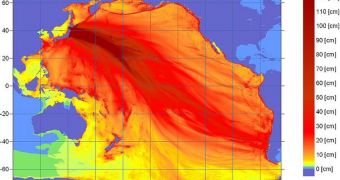The 2011 Tōhoku earthquake that struck Japan on March 11 first affected the ionosphere, the highest layer of Earth's atmosphere, a new study found. The findings are very important because they could be used to create better forecasting tools against tremors.
Interestingly, researchers also determined that the event affected the ionosphere some time before the actual tremor occurred under the surface of the Pacific Ocean. The time span separating the two is not large, but it could prove sufficient to save thousands of lives.
This particular tremor was catastrophic, recording a magnitude of 9.0. It was followed by roughly 1,235 aftershocks, and killed more than 15,800 people, while injuring 5,940 more. According to investigators, the event exhibited a peak acceleration of 3g.
Because it occurred underwater, the Tōhoku earthquake also caused a significant tsunami, which reached a height of no less than 38.9 meters (128 feet) at Miyako city, in the Iwate prefecture.
As they were analyzing data obtained by measurement equipment, geologists learned that the event also triggered atmospheric waves that managed to make their way all the way to the ionosphere. This layer of the atmosphere contains pieces of the mesosphere, thermosphere and exosphere.
The new study was carried out by investigators at the Hokkaido University in Japan, who were coordinated in this effort by geodesist and geophysicist Kosuke Heki. His team is the first to propose that the atmospheric ripples reached so high up.
These interferences were measured by analyzing distortions in GPS signals, as well as anomalies in radio signal transmission patterns around the world. The experts were lucky enough to have access to a network of over 1,000 GPS receivers, installed all around Japan.
The Asian nation is one of the best-prepared and equipped countries in the world when it comes to facing tremors. This type of preparedness also includes monitoring networks, whose data proved invaluable for the new investigation.
Using this system, Heki and his team discovered that the electron content of the ionosphere increased by a total of 8 percent about 40 minutes before the actual earthquake was triggered. Had people been warned so long in advance, the number of victims would have been considerably smaller.
“Before finding this phenomenon, I did not think earthquakes could be predicted at all. Now I think large earthquakes are predictable,” Heki says, quoted by Our Amazing Planet. Details of the study were published in the September 15 issue of the esteemed scientific journal Geophysical Research Letters.

 14 DAY TRIAL //
14 DAY TRIAL //